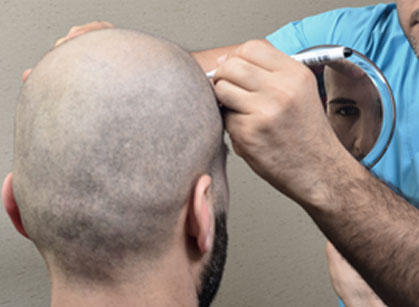In the chronic type, the stressful cause is much less clear (causes may be: adaptation problems, states of anxiety, chronic use of some drugs, inadequate diets, debilitating chronic diseases) and tends leads to a high loss of hair that may last months or years, without any seasonal change or spontaneous remission. In this event, in time it leads to widespread hypotrichosis with varying degrees of severity.
The distinction between Telogen Effluvium and alopecia areata (spot baldness), though quite clear on a clinical level, is instead much more difficult and unclear on a nosological level, even if in the former the hair falls out in the telogen phase and in the latter in the dystrophic anagen phase.
Therefore, Telogen Effluvium or Effluvium is a phenomenon characterized by excessive hair loss (hundreds or sometimes thousands) in the telogen phase. Telogen Effluvium as described by Kligman (*) is an acute event that follows an important episode from an emotional point of view. Patients with Telogen Effluvium often complain about a sense of pain, itchiness and stinging on the scalp.
The cause of this sensation has not yet been explained (many attribute it with a neurotic or psychological nature). The structure of these hairs seen under an electronic microscope is similar to that of normal (terminal) hair, with “mature” hair in the telogen phase and without elements of involution (there is no vellus hair).
Almost always the cause of acute Telogen Effluvium is a stressful, very intense but brief, event that affects hair in the anagen subphase 6, leading them to stop in the telogen phase.
This phenomenon may involve a lot of hair (up to 85%, so all anagen 6 hair), causing a widespread loss that starts after 12-15 weeks to continue for around 3 months (that is, the duration of the telogen phase). In the end the hair loss stops naturally and spontaneously, thereby leading to hair regrowth.
During the effluvium phase the relationship between hair in the anagen phase and hair in the telogen phase (shown by the trichogram) changes a lot: At least 25% and up to 85% of hair is found in the telogen phase in this period. The number of fallen hair (called a Wash test) reaches 600 – 1000 hairs, or even more. By running your fingers through the patient’s hair and pulling delicately (called a Pull test) the hair that remains caught between the fingers can sometimes number in the hundreds. Blood tests are not very useful in the majority of cases. If this Effluvium phase occurs in the post-infective forms, blood chemistry tests show an increase in the number of lymphocytes greater than 33% with a maximum number of 4500 lymphocytes/ml. In time, hypotrichosis may occur, which may be more or less accentuated.
The only effective treatment of acute Telogen Effluvium is to stay away from the cause or causes that caused it. It is very important for the doctor to prescribe the depressed and worried patient a treatment to reassure him/her, show that he is interested and ensure the necessary amount of time passes so that the Effluvium phase passes naturally.
Among the drugs prescribed, corticosteroids work well. In the minor forms, a non-halogenated cortisone cream to be applied locally is prescribed (like for example, hydrocortisone butyrate). Instead, in the more serious forms, an intramuscular injection of 40 mg of methylprednisolone is usually prescribed every 7 – 10 days for around 3 cycles. Almost always results are seen quickly, leading to an effective block of the effluvium and a quick return to the anagen phase by the follicles.
Among the most frequent causes of Chronic Effluvium we note: labor and breast-feeding, collagen diseases, acute physical or psychological stress, poisoning, endocrine disorders, fevers, grief, surgery and blood loss, chronic infectious diseases, deficiencies, neurotic or depressing situations, the chronic use or abuse of drugs and anorexia. In many patients with Telogen Effluvium, we may find leukopenia (an antinuclear antibody test is necessary), autoimmune collagen diseases or systemic lupus erythematosus. Especially in women with Telogen Effluvium, we can find iron-deficiency anemia and a lack of other trace minerals (in particular magnesium and zinc), which are very important to hair physiology. The reduction or lack of minerals and electrolytes (such as iron, magnesium, zinc, calcium, sodium and potassium) must be analyzed and if necessary corrected and integrated.
Among the most frequent causes of chronic Telogen Effluvium we can note: frequent blood donations, serious physical illnesses, chronic systemic diseases (infectious, metabolic or neoplastic diseases), dysthyroidism and chronic drug use (retinoids, interferon, allopurinol, anticonvulsants, antithyroid drugs, beta blockers, heparin, lithium, warfarin, vitamin A and some oral contraceptives). In some cases surgery or hair transplant leads to telogen effluvium due to surgical stress which results in temporary hair loss also in the areas not treated surgically, an occurrence that creates a notable state of anxiety in patients, hair regrowth occurs in the majority of cases in a period varying from three to twelve months.

 English
English  Italiano
Italiano  Français
Français  Español
Español 



